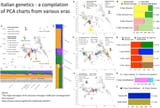Search Results
6/28/2025, 9:48:19 PM
>>17798746
>Genetic studies have indicated that the Iron Age population of Latium was a mixture of preceding Early European Farmers and Western Hunter-Gatherers, with about 30% Steppe ancestry largely coming from the Pontic–Caspian Steppe. However two out of six individuals from Latin burials from Latium vetus were found to be a mixture of local Iron Age ancestry and an ancient Near Eastern population (best approximated by Bronze Age Armenian or Iron Age Anatolian population). In addition, one out of four individuals from Etruscan civilization burials from Veio and Civitavecchia, a female, was found to be a mixture of local Iron Age ancestry and a North African population (best approximated by Late Neolithic Moroccan)
>The results have indicated a substantial migration from the Eastern Mediterranean into the city of Rome and its vicinity in Central Italy during the Principate. Notably, only 2 out of 48 Imperial-era individuals fall in the Spanish-like cluster to which 8 out of 11 Iron Age individuals belong. Instead, two-thirds of Imperial individuals (31 out of 48) overlap with central and eastern Mediterranean populations, such as those from southern and central Italy, Greece, Cyprus, and Malta. An additional quarter (13 out of 48) of the sampled Imperial Romans overlap with Levantine and Near Eastern populations, projecting close to four contemporaneous individuals from Lebanon
>One study indicates that during Late Antiquity this Eastern Mediterranean migration subsides and is replaced by the migration of northern barbarian European nations. Consequently, the ethnic composition begins to take an increasingly European character, a trend that intensifies during the Migration Period and continues even long after the collapse of the Western Roman Empire, as the geopolitics of Italy tie it ever more with its northern neighbors, e.g. via the Holy Roman Empire
>Genetic studies have indicated that the Iron Age population of Latium was a mixture of preceding Early European Farmers and Western Hunter-Gatherers, with about 30% Steppe ancestry largely coming from the Pontic–Caspian Steppe. However two out of six individuals from Latin burials from Latium vetus were found to be a mixture of local Iron Age ancestry and an ancient Near Eastern population (best approximated by Bronze Age Armenian or Iron Age Anatolian population). In addition, one out of four individuals from Etruscan civilization burials from Veio and Civitavecchia, a female, was found to be a mixture of local Iron Age ancestry and a North African population (best approximated by Late Neolithic Moroccan)
>The results have indicated a substantial migration from the Eastern Mediterranean into the city of Rome and its vicinity in Central Italy during the Principate. Notably, only 2 out of 48 Imperial-era individuals fall in the Spanish-like cluster to which 8 out of 11 Iron Age individuals belong. Instead, two-thirds of Imperial individuals (31 out of 48) overlap with central and eastern Mediterranean populations, such as those from southern and central Italy, Greece, Cyprus, and Malta. An additional quarter (13 out of 48) of the sampled Imperial Romans overlap with Levantine and Near Eastern populations, projecting close to four contemporaneous individuals from Lebanon
>One study indicates that during Late Antiquity this Eastern Mediterranean migration subsides and is replaced by the migration of northern barbarian European nations. Consequently, the ethnic composition begins to take an increasingly European character, a trend that intensifies during the Migration Period and continues even long after the collapse of the Western Roman Empire, as the geopolitics of Italy tie it ever more with its northern neighbors, e.g. via the Holy Roman Empire
Page 1
